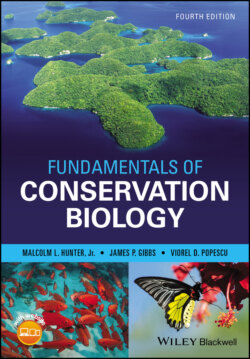Читать книгу Fundamentals of Conservation Biology - Malcolm L. Hunter Jr. - Страница 78
Economic Values
ОглавлениеWhen we think of the economic values of ecosystems in terms of goods and services, the material goods provided by ecosystems can generally be accounted for by summing the goods provided by various species such as the lumber from tree species, the food from fish species, and so on. With services, however, whole ecosystems are often the logical “source of production.” For example, wetlands are often used for treatment of wastewater, a service that would be quite expensive to duplicate with a treatment plant (Gude et al. 2014; Wu et al. 2015), and can play a key role in mitigating floods (Acreman and Holden 2013). Dune and salt‐marsh ecosystems provide an invaluable service during coastal storms by buffering upland areas. Coastal wetlands export nutrients and organic matter to adjacent estuaries where they support economically valuable fisheries (Fig. 4.5). Forests export high‐quality water to aquatic ecosystems and urban water supplies. This list could go on and on because for virtually every ecosystem we could identify services that would be very expensive to replace artificially. Access to the recreational services of ecosystems is the basis for an enormous array of commercial enterprises. These can be as simple as bus trips for city dwellers to visit a forest or lake on a Saturday afternoon, or they can be as all‐inclusive as completely catered “ecotours” to coral reefs, tropical forests, Antarctic islands, and so on (Honey 2008).
Figure 4.5 Relatively few species can tolerate the special conditions of salt marshes, but those that do create ecosystems of great importance. Salt marshes buffer upland areas from ocean storms. They also export large amounts of organic matter to adjacent estuaries, which constitutes a key component of the estuarine food web.
(Trish Hartmann/Flickr/CC BY 2.0)
The economic values of ecosystems for both goods and services were compiled and a grand tally of their economic value estimated by multiplying a value‐per‐hectare figure for each major type of ecosystem by the total global area of that ecosystem (Costanza et al. 1997a). The estimate of $33 trillion per year was considered an average figure because of the nature of various uncertainties within a range of $16 to $64 trillion. To put these figures in perspective, the gross national products of all the world’s nations totaled about $18 trillion at that time.
